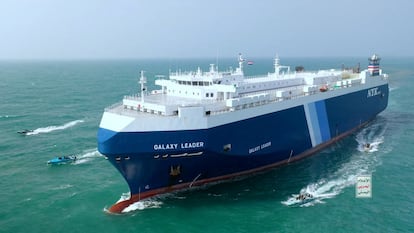Red Sea crisis from Houthi attacks hits world trade as cost of shipping soars by 170%
Companies are rerouting around South Africa to avoid militia attacks in Yemen in one of the biggest disruptions to world trade since the Covid-19 pandemic


Attacks by Yemeni Houthi rebels on merchant ships heading for the Suez Canal via the Red Sea are causing one of the biggest disruptions to world trade since the Covid-19 pandemic. At least 18 shipping lines, including Danish giant Maersk, have already rerouted their vessels around South Africa to avoid passing through the strategic Gulf of Aden, an alternative that makes journeys between Asia and Europe significantly longer and more expensive. The impact on freight rates has been astronomical: they have almost tripled since the attacks, which the rebel militia claims are aimed at punishing Israel for the war in Gaza, intensified in mid-December. The escalating cost of transport threatens the world economy with a further inflationary setback, although experts are confident that the effect will be limited.
The increase in the cost of transport comes at a delicate time for the global economic situation, marked by uncertainty and the hangover from an inflationary escalation (and its effects) that was beginning to subside. Freight booking platform Freightos.com calculates that carrying goods in a 40-foot container (12 meters long, 2.3 meters wide and 2.4 meters high) from Asia to northern Europe now costs $4,000, a 173% increase from mid-December, Bloomberg reports. For cargoes from Asia to the Mediterranean, the price rises to $5,175, and some companies are charging as much as $6,000 on routes due to depart in mid-January. From Asia to the U.S., rates are up less, by 55%, to $3,900.
Meanwhile, another benchmark, the Shanghai Containerized Freight Index (SCFI), which measures rates for transporting imported goods from China, has risen 161% since December 15, from $1,029 to $2,694.
All these prices are roughly double those of 2019, before the pandemic hit global trade, but still well below coronavirus peaks. During the height of that year’s collapse, SCFI index prices exceeded $5,000, double today’s levels.
Even so, the impact of the current crisis in the Middle East is considerable. Shipping lines are changing their routes to avoid the Red Sea, a route through which 12-15% of the world’s trade flows, often around the Cape of Good Hope. " Around 18 shipping companies have already decided to re-route their vessels around south Africa in order to reduce the attacks on vessels and of course the impact this has on seafarers in particular,” said the secretary general of the International Maritime Organization (IMO), Arsenio Dominguez, in an address to the United Nations Security Council. For cargo ships, this means adding 10 days on average to their voyages and higher fuel costs. The crisis has led to a 25% reduction in commercial traffic through the Suez Canal.
Attacks on this trade route began as early as November, shortly after Israel’s ground invasion of Gaza following the attacks by the fundamentalist Hamas militia on October 7. And they have intensified since December. “The initial target was ships linked to Israel, but from the information we have received related to recent events, this doesn’t seem to be the case at the moment,” Dominguez said. Since mid-November, 23 commercial ships have been attacked; the most recent attack was last weekend, against Maersk, even though the United States has launched an operation to patrol the area.
Maersk announced this week that it will again pause routes transiting the Suez Canal, following in the footsteps of the German shipping company Hapag-Lloyd. Meanwhile, France’s CMA-CGM announced a 100% rate increase on routes between Asia and the Mediterranean. Companies increase their rates when their cargo capacity and the frequency of voyages is reduced, in this case because the routes are considerably lengthened by having to change itinerary.
Stock market rises
Investors believe that, by raising fares, they will achieve a higher return even if transport time and fuel costs increase. This has been reflected in the stock markets. Goldman Sachs has just raised its recommendation to buy Maersk shares, which are up 30% in the last month. In the case of Hapag-Lloyd, shares have risen by almost 50% in the same period.
Guaranteeing security in the Red Sea area is very complicated. The Bab al-Mandab Strait, the main access route to the Red Sea between the Arabian Peninsula and the Horn of Africa, is only 30 kilometers (18.6 miles) long, so ships have to pass slowly and in single file, with little room for maneuver. They thus become easy targets for drones launched by the Houthi militia, which opposes Yemen’s official government and controls 30% of the country’s territory. The aim of the rebels, whose main sponsor is Iran, is to punish the ships that trade with Israel, although from the latest attacks it seems that this objective is becoming more and more generalized.
In the first days of the year, traffic in the Suez Canal has fallen by 28% compared to the same period in 2023, according to data from Portwatch, a platform run by the International Monetary Fund (IMF) and Oxford University. In other words, 3.1% of world trade is being redirected from the Red Sea to other routes.
“The longer voyages for diverted services — ranging from 7-14 days of additional sailing depending on the lane — mean longer lead times for importers and some threat of port congestion if updated schedules can’t be maintained and multiple vessels arrive at once, though so far there have not been reports of backlogs,” says Judah Levine, senior analyst at Freightos, on its website. The expert explains that carriers are adding ships to their rotations and sailing at higher speeds to compensate as much as possible for the increase in voyage times.
“But, even with the threat of some congestion and equipment shortages, carriers are much better-positioned to accommodate operationally for these diversions when compared to the disruptions seen during the pandemic,” he adds. Between 2021 and 2022 there were also supply problems, but because demand soared well above supply. Levine explains that as the industry is “already facing significant overcapacity as new vessels continue to be delivered,” there is much greater capacity for reaction to the current crisis.
Transportation costs have a major inflationary impact. Bottlenecks during the pandemic added one percentage point to inflation, according to the IMF. These costs account for 7% of the costs of long-distance imports under normal circumstances (in 2020 they shot up by 25%). Rhys Davies, an advisor at consultancy Flint Global, said a few days ago in The Guardian that the impact of the Red Sea crisis on inflation is likely to be limited: “The effects creep into the economy quite slowly, up to 12 months after the peak [in freight costs], so if the disruption is limited in time, as we expect, it will be offset by other disinflationary impacts.”
Sign up for our weekly newsletter to get more English-language news coverage from EL PAÍS USA Edition
Tu suscripción se está usando en otro dispositivo
¿Quieres añadir otro usuario a tu suscripción?
Si continúas leyendo en este dispositivo, no se podrá leer en el otro.
FlechaTu suscripción se está usando en otro dispositivo y solo puedes acceder a EL PAÍS desde un dispositivo a la vez.
Si quieres compartir tu cuenta, cambia tu suscripción a la modalidad Premium, así podrás añadir otro usuario. Cada uno accederá con su propia cuenta de email, lo que os permitirá personalizar vuestra experiencia en EL PAÍS.
¿Tienes una suscripción de empresa? Accede aquí para contratar más cuentas.
En el caso de no saber quién está usando tu cuenta, te recomendamos cambiar tu contraseña aquí.
Si decides continuar compartiendo tu cuenta, este mensaje se mostrará en tu dispositivo y en el de la otra persona que está usando tu cuenta de forma indefinida, afectando a tu experiencia de lectura. Puedes consultar aquí los términos y condiciones de la suscripción digital.
More information
Archived In
Últimas noticias
Most viewed
- Sinaloa Cartel war is taking its toll on Los Chapitos
- Reinhard Genzel, Nobel laureate in physics: ‘One-minute videos will never give you the truth’
- Oona Chaplin: ‘I told James Cameron that I was living in a treehouse and starting a permaculture project with a friend’
- Why the price of coffee has skyrocketed: from Brazilian plantations to specialty coffee houses
- David King, chemist: ‘There are scientists studying how to cool the planet; nobody should stop these experiments from happening’










































